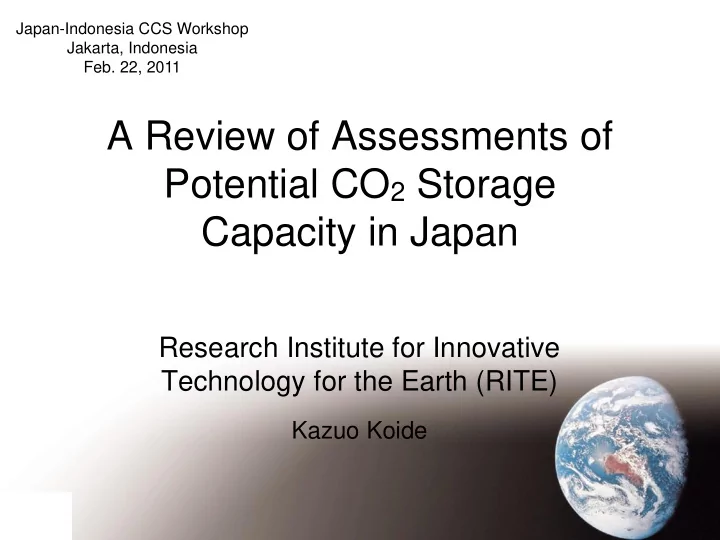

Japan-Indonesia CCS Workshop Jakarta, Indonesia Feb. 22, 2011 A Review of Assessments of Potential CO 2 Storage Capacity in Japan Research Institute for Innovative Technology for the Earth (RITE) Kazuo Koide
Outline Historical review of assessments of potential CO 2 storage capacity in Japan Overview of the reassessment of potential CO 2 storage capacity in Japan by RITE/ENAA* - CO 2 storage concept - Key parameters: Storage factor SupercriticalCO 2 saturation - Geological assumptions Summary Future issues * Engineering Advancement Association of Japan 1
Historical Review Tanaka et al. (1995) - Assessment of potential CO 2 storage capacity in Japan FY2000-2007 (RITE/ENAA) - A part of “CO 2 Geological Storage Project” funded by METI* - Reassessment of potential CO 2 storage capacity in Japan - Assessment of potential CO 2 storage capacity near the large-scale emission sources in Japan FY2008-2011 (NEDO**) - “Innovative Zero -emission Coal Gasification Power Generation Project: Feasibility Study on A Total System from Power Generation to CO 2 Storage” funded by METI - A follow-up project of the RITE/ENAA project - Detailed assessment of high potential areas Activities of Japan CCS Co., Ltd. (JCCS) - Detailed assessments for high potential areas in Japan * Ministry of Economy, Trade and Industry of Japan 2 **New Energy and Industrial Technology Development Organization
Overview of Reassessment Proposal of CO 2 storage concept Areas assessed Making extensive use of the seismic and well data owned by METI for geological interpretations Introduction of a concept of “storage factor” in calculations of potential CO 2 storage capacity Supercritical CO 2 saturation determination Geological assumptions for depth and effective thickness of deep saline aquifers 3
CO 2 Storage Concept Category A Category B Gently Dipping Homoclinal Structures and/or Structural Traps Type of Trap Heterogeneous Aquifers without Trapping Structures A1 Oil and Gas Fields B1 Drilled Structures A2 Undrilled Structures A3 B2 Structural Trapping Stratigraphic/Residual Trapping Primary: Supercritical state Primary: Dissolved in formation water Trap Mechanism Secondary: Dissolved in formation water Secondary: Supercritical state (Stratigraphic and Residual) Storage Concept Actual storage Huge potential in the near future Capacity (modified from Takahashi et al., 2008) 4 4
Calculations of Potential CO 2 Storage Capacity Potential CO 2 storage capacity = S f x A x h x φ x S g /B g CO 2 x ρ Sf: storage factor area (m 2 ) A: h: net thickness (m) (= formation thickness x sand/shale ratio) φ : porosity S g : supercritical CO 2 saturation B g CO 2 : formation volume factor of CO 2 ρ : density of CO 2 at standard conditions (= 1.976 kg/m 3 ) 5 5
“Storage Factor” (S f ) (1) buoyancy viscosity permeability ideal CO 2 storage area reservoir non-reservoir Areal Storage Factor buoyancy Definition of Storage Factor: The ratio of the volume with which viscosity the injected supercritical CO 2 has contact to the pore volume of the permeability entire aquifer. CO 2 storage area S f (Volumetric Storage Factor) reservoir non-reservoir = Areal Storage Factor Vertical Storage Factor x Vertical Storage Factor 6 6
“Storage Factor” (S f ) (2) The idea is based on the concept of Sweep Efficiency in EOR Storage factor values given for calculations of potential CO 2 storage capacity: - Category A: 50% - Category B: 25% Assumptions in determination of storage factor values: - Areal storage factor: nearly 100% - Vertical storage factor: 50% for homogeneous aquifers 25% for aquifers with vertical heterogeneity 7 7
Supercritical CO 2 Saturation (S g ) Retention of two phases of fluids (CO 2 and brine) in deep saline aquifers Assumptions of S g values of 20, 50 and 80% for calculations of potential CO 2 storage capacity Interpretation of supercritical CO 2 saturation based on the results of the monitoring by well logging during the injection at the Nagaoka pilot test site: 40-50% 50% for all categories 8 8
Geological Assumptions: Depth Water depths shallower than 200 m 800 m below seafloor for offshore areas to keep the stored CO 2 in a supercritical state 9 9
Geological Assumptions: Effective Thickness (h) Based on the seismic and well data owned by METI Tertiary-Quaternary sediments: - having a thickness of greater than 800 m - in a water depth shallower than 200 m Calculations of effective thickness for sub-category B2 - Calculations of average effective thicknesses based on the well data - Final effective thickness values: A total of average effective thicknesses x 0.5 10 10
Distribution Map of CO 2 Storage Capacity Exploratory Wells by METI Seismic Surveys by METI 11 11 (modified from Takahashi et al., 2008)
Calculated Potential CO 2 Storage Capacity Capacity Categories Remarks (Mt-CO 2 ) A1 3,492 Including onshore ares A A2 5,202 Including onshore ares A3 21,393 B1 27,532 Including onshore areas B B2 88,477 Total 146,096 Note: Inland basins and inner bays are not included. A1 2% A2 4% A3 15% B2 B1 60% 19% 12 12
Summary An overview of the reassessment of potential CO 2 storage capacity in Japan by RITE/ENAA is focused Key points in the reassessment of potential CO 2 storage capacity: - Proposal of CO 2 storage concept: Two major categories - Introduction of a concept of “storage factor” - Determination of supercritical CO 2 saturation value based on the results of the monitoring at the Nagaoka pilot test site - Geological assumptions for depth and effective thickness of aquifers Japan has a huge potential CO 2 storage capacity in deep saline aquifers 13 13
Future Issues Detailed assessment of potential CO 2 storage capacity in high-potential areas by 3D geological modeling and numerical simulations Seismic surveys in shallow water areas Basic laboratory research for better understanding of CO 2 behavior in the subsurface 14 14
Thank you for your attention ! GHGT-11 Kyoto November 2012 15 15
Recommend
More recommend